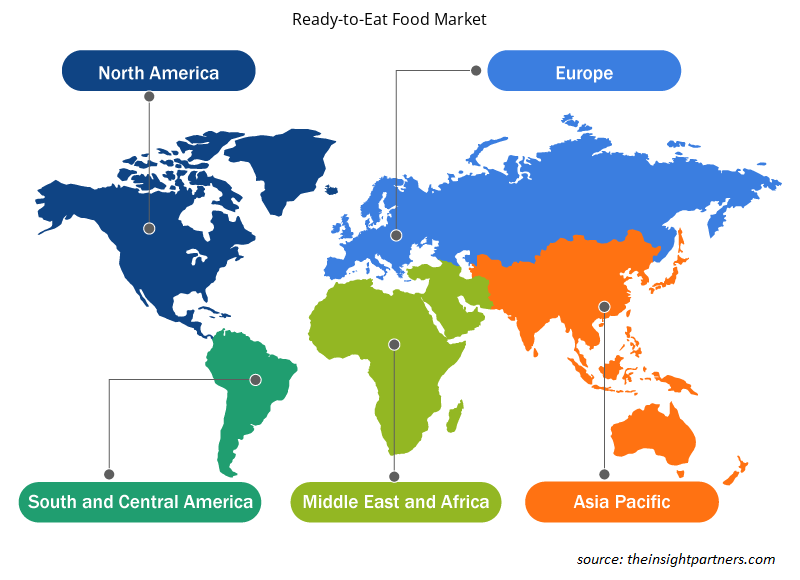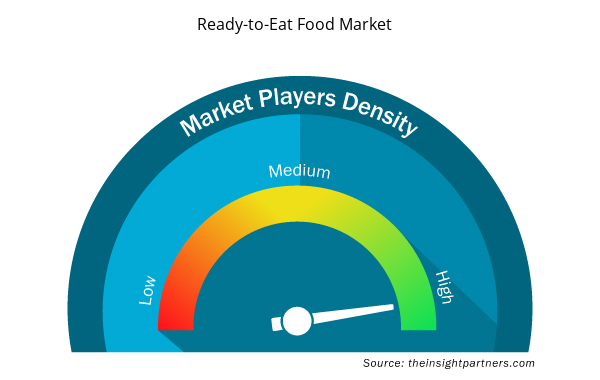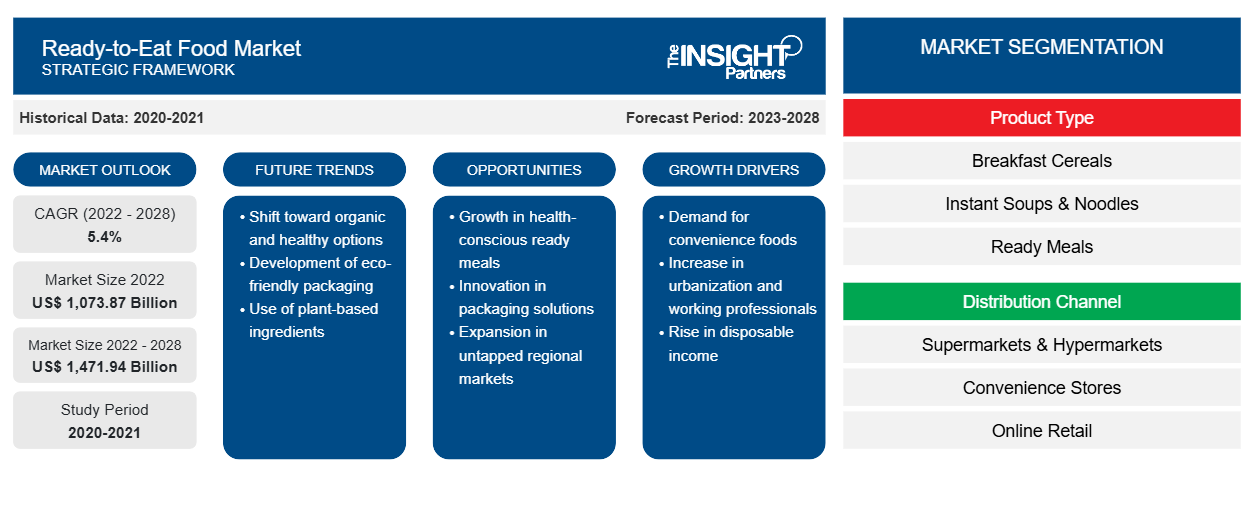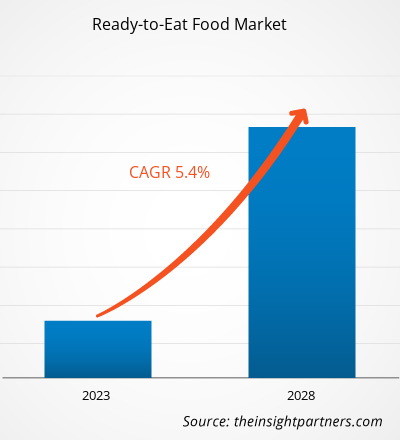[Forschungsbericht] Der Markt für verzehrfertige Lebensmittel soll von 1.073,87 Milliarden US-Dollar im Jahr 2022 auf 1.471,94 Milliarden US-Dollar im Jahr 2028 anwachsen. Von 2022 bis 2028 wird mit einer durchschnittlichen jährlichen Wachstumsrate von 5,4 % gerechnet.
Verzehrfertige Lebensmittel sind verschiedene verarbeitete und verpackte Lebensmittel, die ohne weitere Zubereitung verzehrt werden können. Die Zutaten werden gewaschen, gekocht, verarbeitet und zum direkten Verzehr in Behälter verpackt. Einige gängige Arten von verzehrfertigen Lebensmitteln sind Instantsuppen, Backwaren, Desserts und Fertiggerichte. Diese Produkte sind mit verschiedenen Extrakten, Säuren, Aromen, Süßstoffen , Antioxidantien und Konservierungsstoffen angereichert. Sie bieten dem Verbraucher enormen Komfort, tragen zur Verkürzung der Zubereitungszeit bei und sorgen für eine längere Haltbarkeit der Produkte, Kosteneffizienz und minimalen Verderb.
Der asiatisch-pazifische Raum hatte im Jahr 2020 den größten Anteil am Markt für verzehrfertige Lebensmittel , während andere Entwicklungsregionen wie der Nahe Osten und Afrika im Prognosezeitraum voraussichtlich deutlich wachsen werden. Wichtige Akteure auf dem Markt für verzehrfertige Lebensmittel weiten ihre Aktivitäten im asiatisch-pazifischen Raum aus, da die Erwerbsbevölkerung zunimmt und die Menschen in Entwicklungsländern einen hektischen Lebensstil pflegen. Immer mehr Menschen entscheiden sich dafür, unterwegs oder außer Haus zu essen.
Darüber hinaus haben zahlreiche Studien ergeben, dass transnationale Lebensmittel- und Getränkekonzerne (TFBCs) die Lebensmittelsysteme und den allgemeinen Konsum auf eine Weise geprägt haben, die die Verfügbarkeit, Attraktivität, den Preis und letztlich den Konsum verarbeiteter Lebensmittel verändert. Das Wachstum des Marktes für verzehrfertige Lebensmittel ist vor allem in Ländern mit mittlerem Einkommen zu beobachten.TFBCs) have shaped food systems and general consumption in ways, which change the availability, desirability, price, and ultimately consumption of processed foods. The growth of ready-to-eat food market has been prominently observed in middle-income countries.
Passen Sie diesen Bericht Ihren Anforderungen an
Sie erhalten kostenlose Anpassungen an jedem Bericht, einschließlich Teilen dieses Berichts oder einer Analyse auf Länderebene, eines Excel-Datenpakets sowie tolle Angebote und Rabatte für Start-ups und Universitäten.
- Holen Sie sich die wichtigsten Markttrends aus diesem Bericht.Dieses KOSTENLOSE Beispiel umfasst eine Datenanalyse von Markttrends bis hin zu Schätzungen und Prognosen.
Auswirkungen der COVID-19-Pandemie auf den Markt für verzehrfertige Lebensmittel
Die COVID-19-Pandemie brachte Anfang 2020 beispiellose Herausforderungen für viele Branchen mit sich. Lockdowns, Grenzbeschränkungen, Reiseverbote, Produktionsunterbrechungen und andere Sicherheitsmaßnahmen, die von Regierungen gemäß den Richtlinien der WHO und der nationalen Gesundheitsministerien eingeführt wurden, behinderten die Produktionsabläufe. Andererseits wirkte sich der COVID-19-Ausbruch positiv auf den Markt für verzehrfertige Lebensmittel aus, da Verbraucher und Einzelhändler Fertiggerichte mit längerer Haltbarkeit auf Vorrat kauften. Auch Verbraucher, die nach gesünderen verpackten Lebensmitteln und Getränken zur Stärkung ihrer Immunität suchten, waren durch die Auswirkungen von COVID-19 alarmiert. Dann konzentrierten sich die Hersteller von verzehrfertigen Produkten auf gesunde und nahrhafte Produkte mit Anreicherung von Proteinen und anderen Nährwerten, was die Nachfrage nach verzehrfertigen Lebensmitteln während der Pandemie ankurbelte.Lockdowns, border restrictions, travel bans, manufacturing discontinuation, and other safety measures rolled out by governments as per the guidelines of the WHO, and national health ministries hampered the manufacturing operations. On the other hand, the COVID-19 outbreak positively impacted the ready-to-eat food market as consumers and retailers were stockpiling convenience food products with longer shelves. Also, consumers looking for healthier packaged food and beverage products to boost immunity were alarmed by the COVID-19 impact. Then, manufacturers of RTE products focused on healthy and nutritious products with enrichment of proteins and other nutritional values, which stimulated the demand for ready-to-eat food products during the pandemic.
Markteinblicke
Starke Vorliebe für Convenience Food unter Millennials treibt Marktwachstum an
Der Konsum hochwertiger Fertiggerichte nimmt zu und ist derzeit einer der größten Trends in der Lebensmittelindustrie. Mit Fertiggerichten wie RTE-Produkten sparen Verbraucher Zeit und Aufwand bei der Zubereitung und dem Kochen, dem Verzehr und den Aktivitäten nach dem Essen. Als Wachstumstreiber für dieses Lebensmittelsegment gelten zahlreiche gesellschaftliche Veränderungen, insbesondere die zunehmende Zahl kleinerer Haushalte und die wachsende Zahl der Millennials weltweit. Aufgrund ihres hektischen Arbeitsalltags möchten Millennials ihre Zeit lieber effizient nutzen, als sie mit langweiligen Aufgaben zu vergeuden. Sie geben ihr Geld eher für Convenience-Produkte aus. Daher bevorzugen sie zunehmend RTE-Produkte wie Backwaren, Snacks und Milchprodukte, was den Markt für verzehrfertige Lebensmittel weiter ankurbelt.millennials, they prefer to be efficient with their time rather than wasting it on tedious tasks. They are more likely to spend their money on convenience. Thus, they increasingly prefer RTE products, such as baked products, snacks, and dairy products, further driving the ready-to-eat food market.
Einblicke in Produkttypen
Basierend auf dem Produkttyp ist der Markt für verzehrfertige Lebensmittel in Frühstückszerealien, Instantsuppen und -nudeln, Fertiggerichte, Snacks, Backwaren und Süßwaren und Sonstiges unterteilt. Das Segment der sonstigen verzehrfertigen Lebensmittel wird im Prognosezeitraum voraussichtlich den größten Anteil verzeichnen. Weitere Typen sind Milchprodukte, Desserts, Brotaufstriche, Saucen und Dips. Verzehrfertige Milchprodukte sind Eiscreme, Joghurt, abgepackte aromatisierte Milch und Käse. Gesundheitsbewusste Verbraucher konsumieren hauptsächlich Milchprodukte, da herkömmliche Milchprodukte die Knochen- und Darmgesundheit verbessern und das Risiko von Herz-Kreislauf-Erkrankungen (CVDs) und Typ-2-Diabetes verringern. Die Beliebtheit von verarbeiteten und abgepackten Saucen und Dips wuchs, als die Menschen von traditionellen Lebensweisen abwichen und einen modernen Lebensstil annahmen, was das Wachstum des Marktes für verzehrfertige Lebensmittel ankurbelte.CVDs) and type 2 diabetes. The popularity of processed and packaged sauces and dips grew as people switched from traditional ways of living and adopted a modern lifestyle, fueling the growth of ready-to-eat food market.
Regionale Einblicke in den Markt für verzehrfertige Lebensmittel
Die regionalen Trends und Faktoren, die den Markt für verzehrfertige Lebensmittel während des Prognosezeitraums beeinflussen, wurden von den Analysten von Insight Partners ausführlich erläutert. In diesem Abschnitt werden auch Marktsegmente und Geografien für verzehrfertige Lebensmittel in Nordamerika, Europa, im asiatisch-pazifischen Raum, im Nahen Osten und Afrika sowie in Süd- und Mittelamerika erörtert.

- Erhalten Sie regionale Daten zum Markt für verzehrfertige Lebensmittel
Umfang des Marktberichts über verzehrfertige Lebensmittel
| Berichtsattribut | Details |
|---|---|
| Marktgröße im Jahr 2022 | 1.073,87 Milliarden US-Dollar |
| Marktgröße bis 2028 | 1.471,94 Milliarden US-Dollar |
| Globale CAGR (2022 - 2028) | 5,4 % |
| Historische Daten | 2020-2021 |
| Prognosezeitraum | 2023–2028 |
| Abgedeckte Segmente | Nach Produkttyp
|
| Abgedeckte Regionen und Länder | Nordamerika
|
| Marktführer und wichtige Unternehmensprofile |
|
Marktdichte von Fertiggerichten: Auswirkungen auf die Geschäftsdynamik
Der Markt für verzehrfertige Lebensmittel wächst rasant. Die Nachfrage der Endverbraucher steigt aufgrund von Faktoren wie sich entwickelnden Verbraucherpräferenzen, technologischen Fortschritten und einem größeren Bewusstsein für die Vorteile des Produkts. Mit der steigenden Nachfrage erweitern Unternehmen ihr Angebot, entwickeln Innovationen, um die Bedürfnisse der Verbraucher zu erfüllen, und nutzen neue Trends, was das Marktwachstum weiter ankurbelt.
Die Marktteilnehmerdichte bezieht sich auf die Verteilung der Firmen oder Unternehmen, die in einem bestimmten Markt oder einer bestimmten Branche tätig sind. Sie gibt an, wie viele Wettbewerber (Marktteilnehmer) in einem bestimmten Marktraum im Verhältnis zu seiner Größe oder seinem gesamten Marktwert präsent sind.
Die wichtigsten Unternehmen auf dem Markt für verzehrfertige Lebensmittel sind:
- Nestlé SA
- Conagra Brands Inc.
- Die Kraft Heinz Company
- General Mills Inc.
- CAMPBELL SOUP COMPANY
Haftungsausschluss : Die oben aufgeführten Unternehmen sind nicht in einer bestimmten Reihenfolge aufgeführt.

- Überblick über die wichtigsten Akteure auf dem Markt für verzehrfertige Lebensmittel
Einblicke in Vertriebskanäle
Basierend auf den Vertriebskanälen wurde der Markt für verzehrfertige Lebensmittel in Supermärkte und Hypermärkte, Convenience Stores, Online-Einzelhandel und andere unterteilt. Der Online-Einzelhandel wird im Prognosezeitraum voraussichtlich die höchste durchschnittliche jährliche Wachstumsrate im Markt für verzehrfertige Lebensmittel verzeichnen. Der Online-Einzelhandel bietet den Benutzern ein bequemes Einkaufserlebnis, gefolgt von einer vereinfachten Produktlieferung. Online-Einzelhandelsgeschäfte bieten eine breite Produktpalette zu hohen Rabatten; außerdem können Verbraucher gewünschte Produkte bequem aus der Ferne kaufen.
Die wichtigsten Akteure auf dem Markt für verzehrfertige Lebensmittel sind Nestlé SA; Conagra Brands Inc.; The Kraft Heinz Company; General Mills Inc.; CAMPBELL SOUP COMPANY; MTR Foods Pvt Ltd.; Hormel Foods Corporation; Tyson Foods, Inc.; JBS SA; und The Kellogg Company. Diese Akteure entwickeln Produkte mit reduzierten Gesundheitsrisiken, um aufkommende Verbrauchertrends zu erfüllen und gesetzliche Rahmenbedingungen einzuhalten. Sie sind an Fusionen und Übernahmen, Geschäftserweiterungen und Partnerschaften beteiligt, um ihren Marktanteil zu vergrößern.
Bericht-Spotlights
- Fortschrittliche Branchentrends im Markt für verzehrfertige Lebensmittel helfen den Akteuren bei der Entwicklung wirksamer langfristiger Strategien
- Einführung von Geschäftswachstumsstrategien zur Sicherung des Wachstums in entwickelten und sich entwickelnden Märkten
- Quantitative Analyse des Marktes für verzehrfertige Lebensmittel von 2019 bis 2028
- Schätzung der weltweiten Nachfrage nach verzehrfertigen Lebensmitteln
- Porters Fünf-Kräfte-Analyse zur Veranschaulichung der Wirksamkeit der in der Branche tätigen Käufer und Lieferanten
- Aktuelle Entwicklungen zum Verständnis des Wettbewerbsmarktszenarios
- Markttrends und -aussichten sowie Faktoren, die das Wachstum des Marktes für verzehrfertige Lebensmittel bestimmen
- Unterstützung im Entscheidungsprozess durch Aufzeigen von Marktstrategien, die das kommerzielle Interesse untermauern und zum Marktwachstum führen
- Größe des Marktes für verzehrfertige Lebensmittel an verschiedenen Knotenpunkten
- Detaillierte Übersicht und Segmentierung des Marktes und der RTE-Produktbranchendynamik
- Ausmaß des Wachstums in verschiedenen Regionen mit vielversprechenden Wachstumschancen
- Historische Analyse (2 Jahre), Basisjahr, Prognose (7 Jahre) mit CAGR
- PEST- und SWOT-Analyse
- Marktgröße Wert/Volumen – Global, Regional, Land
- Branche und Wettbewerbsumfeld
- Excel-Datensatz


- Advanced Planning and Scheduling Software Market
- Antibiotics Market
- Mice Model Market
- Dropshipping Market
- Green Hydrogen Market
- Nuclear Decommissioning Services Market
- Arterial Blood Gas Kits Market
- Social Employee Recognition System Market
- Emergency Department Information System (EDIS) Market
- HVAC Sensors Market

Report Coverage
Revenue forecast, Company Analysis, Industry landscape, Growth factors, and Trends

Segment Covered
This text is related
to segments covered.

Regional Scope
North America, Europe, Asia Pacific, Middle East & Africa, South & Central America

Country Scope
This text is related
to country scope.
Häufig gestellte Fragen
The major players operating in the global ready-to-eat food market are Nestlé SA; Conagra Brands Inc.; The Kraft Heinz Company; General Mills Inc.; CAMPBELL SOUP COMPANY; MTR Foods Pvt Ltd.; Hormel Foods Corporation; Tyson Foods, Inc.; JBS S.A.; The Kellogg Company.
In 2020, Asia Pacific accounted for the largest share of the global ready-to-eat food market. Many Asia Pacific countries, such as China and India, are among the world's fastest-growing populations. The food industry is anticipated to expand at a faster pace as a result of increasing population, rising urbanization, and rapid development of suburban areas. The growing middle class coupled with increasing disposable income in the developing countries of Asia Pacific is expected to result in high growth rate for the region over forecast period.
In 2020, the supermarkets and hypermarkets segment accounted for the largest market share. The penetration of supermarkets and hypermarkets is rapidly expanding globally with big retailers such as Walmart expanding into many developing countries in Asia Pacific. Supermarkets and hypermarkets are one stop shop for numerous ready-to-eat food and offers large discounts due to economies of scale. The convenience and discounts offered by supermarkets and hypermarkets has resulted in dominant share for the segment in the ready-to-eat food market.
On the basis of product type, ready meals is the fastest growing segment. The growing hectic schedules as well as evolving lifestyles has led consumers to increasingly seek ready meals. Moreover, the increasing working women population has led to working households, resulting in less time for meal preparation. Thus, ready meals are increasingly being consumed as they offer convenience.
Rise in working women population is a key driver of global ready-to-eat food market. In Asia, female labor force participation ranges from 16% in Afghanistan to 83% in Nepal, further growing in several other countries in the region. According to the “International Labor Organization,†the female employment rate in Germany was 42.50% in 1990 and has increased to 54.91% by 2020. Similarly, the female employment rates in other countries such as the US, France, Chile, and Mexico have surged in recent times.
Innovations in RTE products and strategic developments by manufacturers is expected to offer lucrative opportunities in the market. Major manufacturers are employing creative strategies such as new product releases and production capacity scaleup to better serve their customers and satisfy their growing demands. In May 2018, Del Monte Foods, Inc., a prominent processed food company, launched a canned Gold Pineapple line with a major focus on teenagers as a target consumer group. Major RTE product manufacturers are collaborating and partnering with other market players to launch innovative products in the market. The aforementioned factors have led to increased opportunities for ready-to-eat food market.
Trends and growth analysis reports related to Food and Beverages : READ MORE..
The List of Companies - Ready-to-Eat Food Market
- Nestlé SA
- Conagra Brands Inc.
- The Kraft Heinz Company
- General Mills Inc.
- CAMPBELL SOUP COMPANY
- MTR Foods Pvt Ltd.
- Hormel Foods Corporation
- Tyson Foods, Inc.
- JBS S.A.
- The Kellogg Company
The Insight Partners performs research in 4 major stages: Data Collection & Secondary Research, Primary Research, Data Analysis and Data Triangulation & Final Review.
- Data Collection and Secondary Research:
As a market research and consulting firm operating from a decade, we have published and advised several client across the globe. First step for any study will start with an assessment of currently available data and insights from existing reports. Further, historical and current market information is collected from Investor Presentations, Annual Reports, SEC Filings, etc., and other information related to company’s performance and market positioning are gathered from Paid Databases (Factiva, Hoovers, and Reuters) and various other publications available in public domain.
Several associations trade associates, technical forums, institutes, societies and organization are accessed to gain technical as well as market related insights through their publications such as research papers, blogs and press releases related to the studies are referred to get cues about the market. Further, white papers, journals, magazines, and other news articles published in last 3 years are scrutinized and analyzed to understand the current market trends.
- Primary Research:
The primarily interview analysis comprise of data obtained from industry participants interview and answers to survey questions gathered by in-house primary team.
For primary research, interviews are conducted with industry experts/CEOs/Marketing Managers/VPs/Subject Matter Experts from both demand and supply side to get a 360-degree view of the market. The primary team conducts several interviews based on the complexity of the markets to understand the various market trends and dynamics which makes research more credible and precise.
A typical research interview fulfils the following functions:
- Provides first-hand information on the market size, market trends, growth trends, competitive landscape, and outlook
- Validates and strengthens in-house secondary research findings
- Develops the analysis team’s expertise and market understanding
Primary research involves email interactions and telephone interviews for each market, category, segment, and sub-segment across geographies. The participants who typically take part in such a process include, but are not limited to:
- Industry participants: VPs, business development managers, market intelligence managers and national sales managers
- Outside experts: Valuation experts, research analysts and key opinion leaders specializing in the electronics and semiconductor industry.
Below is the breakup of our primary respondents by company, designation, and region:

Once we receive the confirmation from primary research sources or primary respondents, we finalize the base year market estimation and forecast the data as per the macroeconomic and microeconomic factors assessed during data collection.
- Data Analysis:
Once data is validated through both secondary as well as primary respondents, we finalize the market estimations by hypothesis formulation and factor analysis at regional and country level.
- Macro-Economic Factor Analysis:
We analyse macroeconomic indicators such the gross domestic product (GDP), increase in the demand for goods and services across industries, technological advancement, regional economic growth, governmental policies, the influence of COVID-19, PEST analysis, and other aspects. This analysis aids in setting benchmarks for various nations/regions and approximating market splits. Additionally, the general trend of the aforementioned components aid in determining the market's development possibilities.
- Country Level Data:
Various factors that are especially aligned to the country are taken into account to determine the market size for a certain area and country, including the presence of vendors, such as headquarters and offices, the country's GDP, demand patterns, and industry growth. To comprehend the market dynamics for the nation, a number of growth variables, inhibitors, application areas, and current market trends are researched. The aforementioned elements aid in determining the country's overall market's growth potential.
- Company Profile:
The “Table of Contents” is formulated by listing and analyzing more than 25 - 30 companies operating in the market ecosystem across geographies. However, we profile only 10 companies as a standard practice in our syndicate reports. These 10 companies comprise leading, emerging, and regional players. Nonetheless, our analysis is not restricted to the 10 listed companies, we also analyze other companies present in the market to develop a holistic view and understand the prevailing trends. The “Company Profiles” section in the report covers key facts, business description, products & services, financial information, SWOT analysis, and key developments. The financial information presented is extracted from the annual reports and official documents of the publicly listed companies. Upon collecting the information for the sections of respective companies, we verify them via various primary sources and then compile the data in respective company profiles. The company level information helps us in deriving the base number as well as in forecasting the market size.
- Developing Base Number:
Aggregation of sales statistics (2020-2022) and macro-economic factor, and other secondary and primary research insights are utilized to arrive at base number and related market shares for 2022. The data gaps are identified in this step and relevant market data is analyzed, collected from paid primary interviews or databases. On finalizing the base year market size, forecasts are developed on the basis of macro-economic, industry and market growth factors and company level analysis.
- Data Triangulation and Final Review:
The market findings and base year market size calculations are validated from supply as well as demand side. Demand side validations are based on macro-economic factor analysis and benchmarks for respective regions and countries. In case of supply side validations, revenues of major companies are estimated (in case not available) based on industry benchmark, approximate number of employees, product portfolio, and primary interviews revenues are gathered. Further revenue from target product/service segment is assessed to avoid overshooting of market statistics. In case of heavy deviations between supply and demand side values, all thes steps are repeated to achieve synchronization.
We follow an iterative model, wherein we share our research findings with Subject Matter Experts (SME’s) and Key Opinion Leaders (KOLs) until consensus view of the market is not formulated – this model negates any drastic deviation in the opinions of experts. Only validated and universally acceptable research findings are quoted in our reports.
We have important check points that we use to validate our research findings – which we call – data triangulation, where we validate the information, we generate from secondary sources with primary interviews and then we re-validate with our internal data bases and Subject matter experts. This comprehensive model enables us to deliver high quality, reliable data in shortest possible time.


 Holen Sie sich ein kostenloses Muster für diesen Bericht
Holen Sie sich ein kostenloses Muster für diesen Bericht